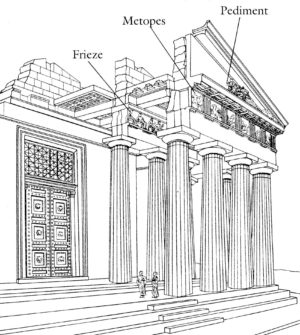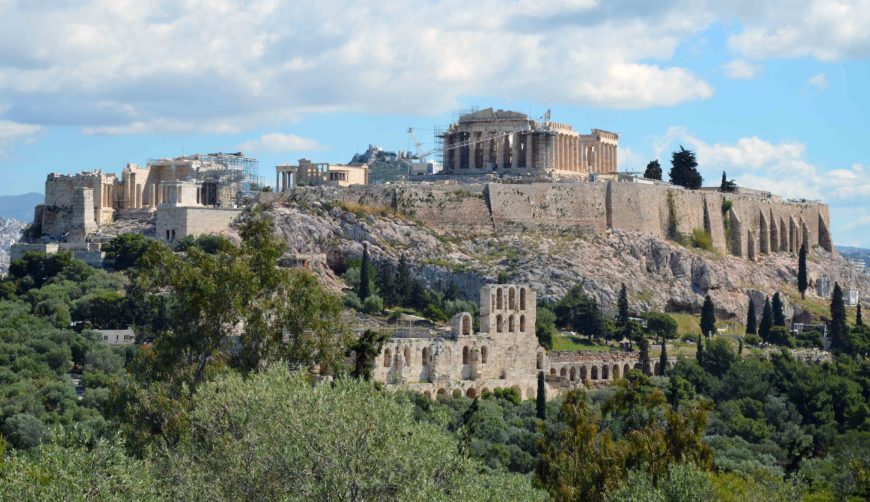
The Acropolis of Athens viewed from the Hill of the Muses (photo: Carole Raddato, CC BY-SA 2.0)
The Parthenon, as it appears today on the summit of the Acropolis, seems like a timeless monument—one that has been seamlessly transmitted from its moment of creation, some two and a half millennia ago, to the present. But this is not the case. In reality, the Parthenon has had instead a rich and complex series of lives that have significantly affected both what is left, and how we understand what remains.
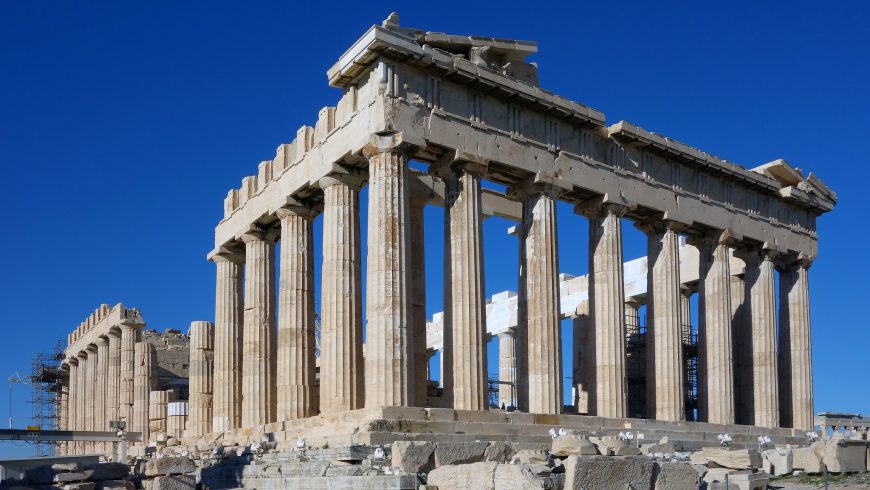
Iktinos and Kallikrates, Parthenon, Acropolis, Athens, 447–432 B.C.E. (photo: Steven Zucker, CC BY-NC-SA 2.0)
It is illuminating to examine the Parthenon’s ancient lives: its genesis in the aftermath of the Persian sack of the Acropolis in 490 B.C.E.; its accretions in the Hellenistic and Roman eras; and its transformation as the Roman empire became Christian. Why was the building created, and how was it understood by its first viewers? How did its meanings change over time? And why did it remain so important, even in Late Antiquity, that it was converted from a polytheist temple into a Christian church?
Investigating the many lives of the Parthenon has much to tell us about how we perceive (and misperceive) this famous ancient monument. It is also relevant to broader debates about monuments and cultural heritage. In recent years, there have been repeated calls to tear down or remove contested monuments, for instance, statues of Confederate generals in the southern United States. While these calls have been condemned by some as ahistorical, the experience of the Parthenon offers a different perspective. What it suggests is that monuments, while seemingly permanent, are in fact regularly altered; their natural condition is one of adaptation, transformation, and even destruction.
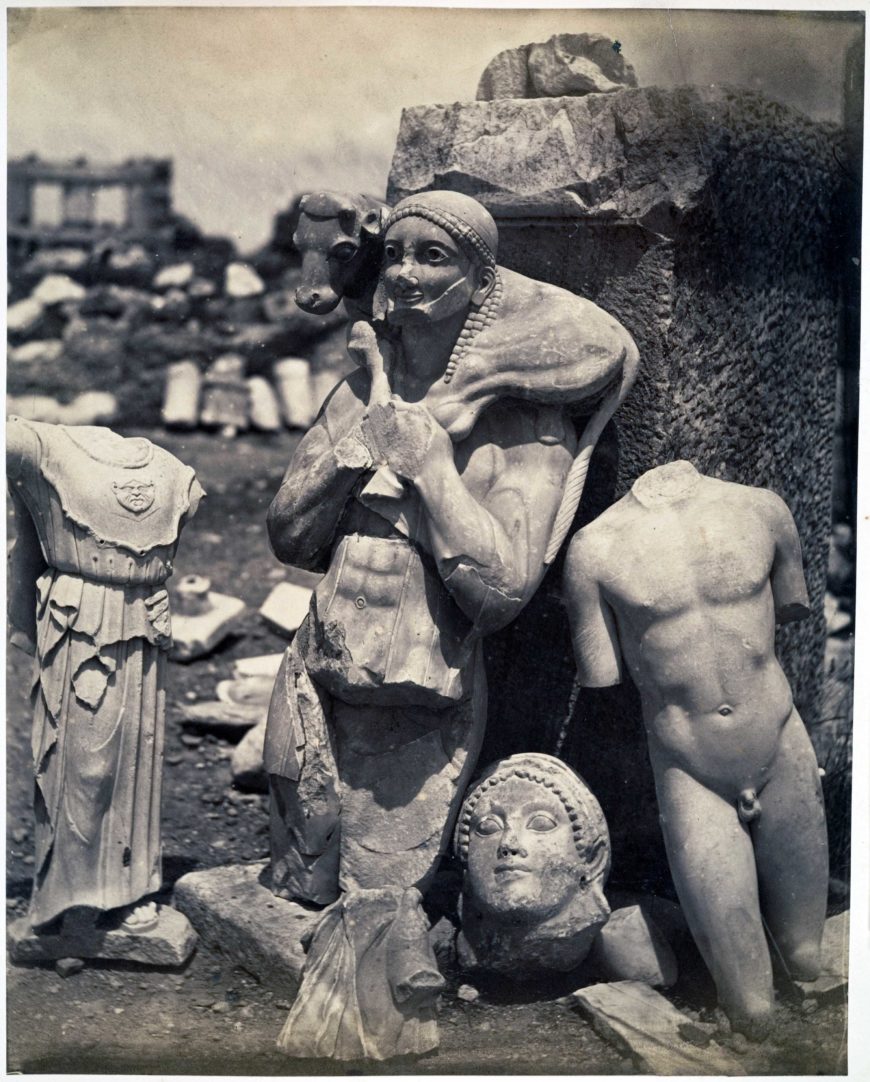
When Persians sacked Athens, they destroyed or damaged many sculptures, including the now-famous Calf-Bearer (today in the Acropolis Museum). Athenians buried many of these sculptures in a pit, which were not uncovered until the 19th century. Unknown photographer, The Calf-Bearer and the Kritios Boy Shortly After Exhumation on the Acropolis, 1865, albumen silver print from glass negative, 27.7 × 21.8 cm (The Metropolitan Museum of Art)
The Genesis of the Parthenon, 480–432 BCE
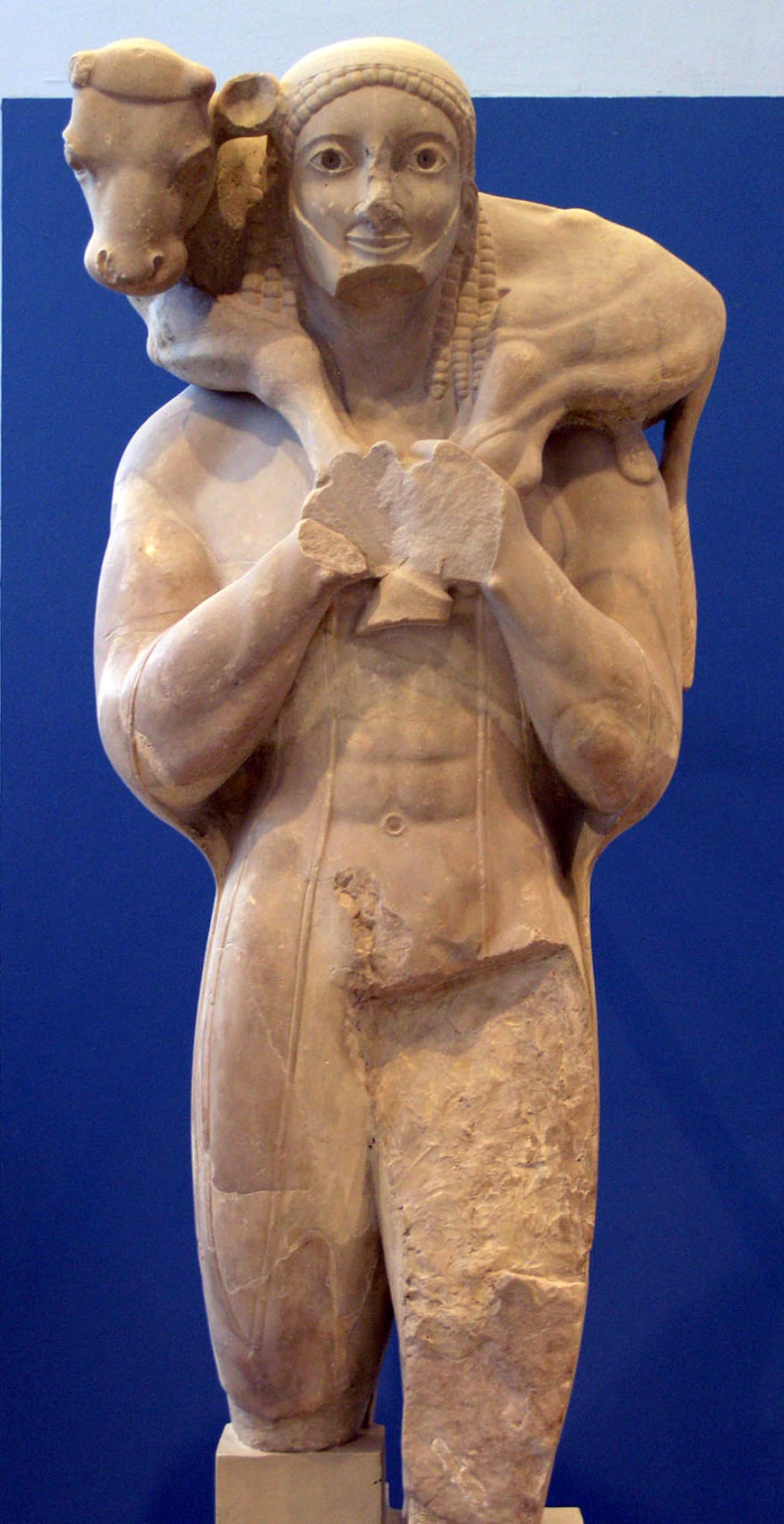
The Moschophoros or Calf-bearer, c. 570 B.C.E., marble 165 m high (Museum of the Acropolis of Athens; photo: Marsysas, CC BY-SA 2.5)
The Parthenon we see today was not created ex novo. Instead, it was the final monument in a series, with perhaps as many as three Archaic predecessors. The penultimate work in this series was a marble building, almost identical in scale and on the same site as the later Parthenon, initiated in the aftermath of the First Persian War.
In the war in 492–490 B.C.E., Athens played a central role in the defeat of the Persians. Thus it is not surprising that ten years later when the Persians returned to Greece, they made for Athens; nor that, when they took the city, they sacked it with particular fervor. In the sack, they paid special attention to the Acropolis, Athens’s citadel. The Persians not only looted the rich sanctuaries at the summit, but also burned buildings, overturned statues, and smashed pots.
When the Athenians returned to the ruins of their city, they faced the question of what to do with their desecrated sanctuaries. They had to consider not only how to commemorate the destruction they had suffered, but also how to celebrate, through the rebuilding, their eventual victory in the Persian Wars.
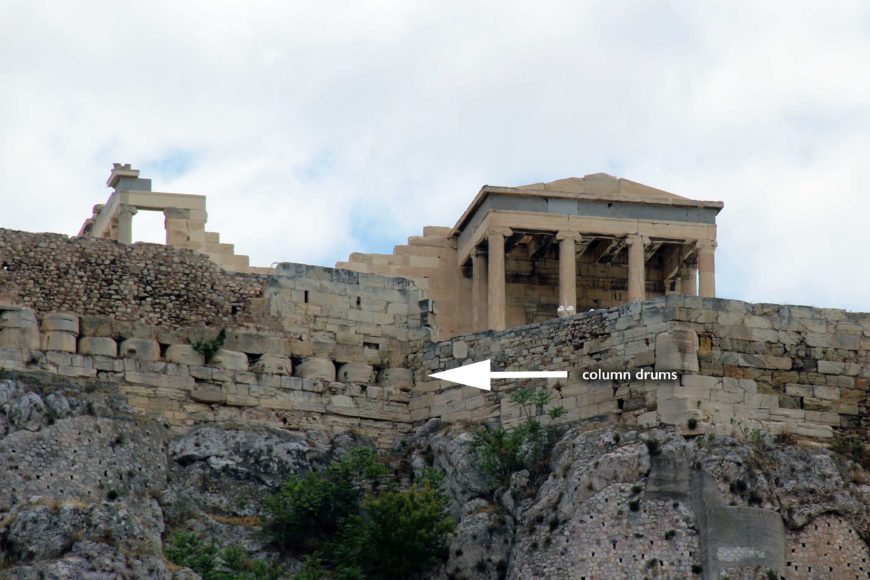
Remains of materials from the temples destroyed during the Persian sack of the Acropolis, such as column-drums (shown here) and a triglyph-metope frieze, were incorporated into the North Wall (photo: Gary Todd)
The Athenians found no immediate solution to their challenge. Instead, for the next thirty years they experimented with a range of strategies to come to terms with their history. They left the temples themselves in ruins, despite the fact that the Acropolis continued to be a working sanctuary. They did, however, rebuild the walls of the citadel, incorporating within them some fire-damaged materials from the destroyed temples. They also created a new, more level surface on the Acropolis through terracing; in this fill, they buried all the sculptures damaged in the Persian sack. These actions, most likely initiated in the immediate aftermath of the destruction, were the only major interventions on the Acropolis for over thirty years.
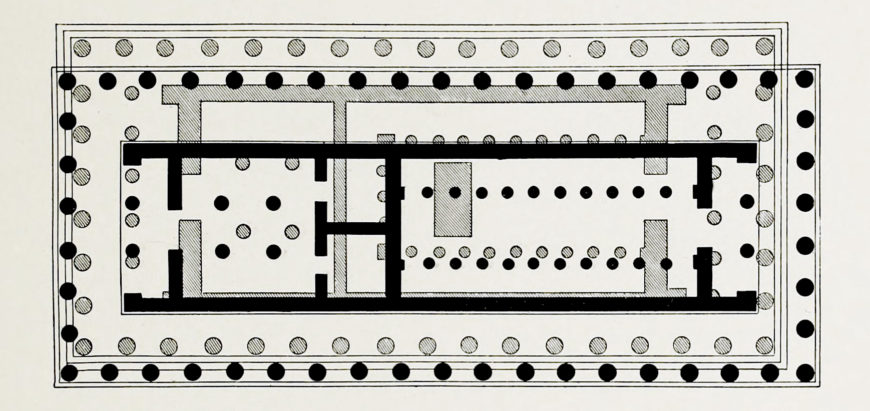
Plan of the Older Parthenon (in black) superimposed on that of the Parthenon (in gray). Plan by Maxime Collignon
In the mid-fifth century B.C.E., the Athenians decided, finally, to rebuild. On the site of the great marble temple burned by the Persians, they constructed a new one: the Parthenon we know today. They set it on the footprint of the earlier building, with only a few alterations; they also re-used in its construction every block from the Older Parthenon that had not been damaged by fire. In their recycling of materials, the Athenians saved time and expense, perhaps as much as one-quarter of the cost of construction.
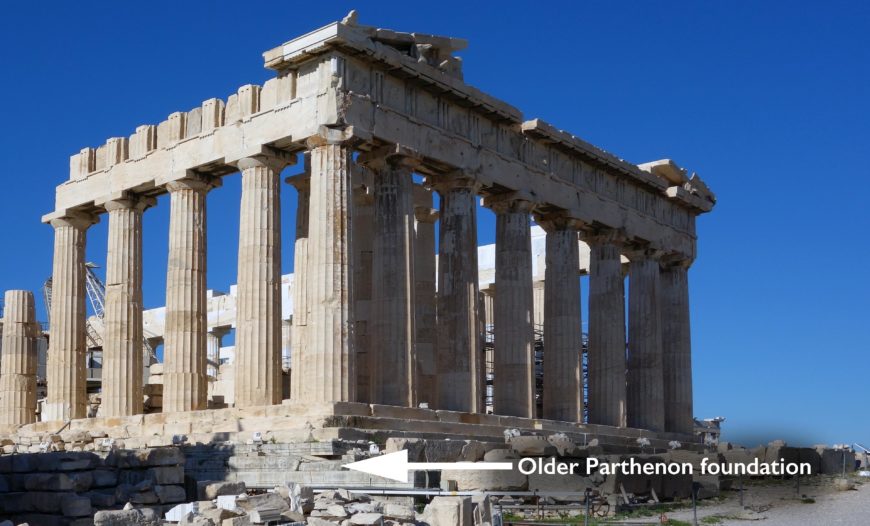
The Older Parthenon foundation is located below the newer construction (photo: Steven Zucker, CC BY-NC-SA 2.0)
At the same time, their re-use had advantages beyond the purely pragmatic. As they rebuilt on the footprint of the damaged temple and re-used its blocks, the Athenians could imagine that the Older Parthenon was reborn—larger and more impressive, but still intimately connected to the earlier sanctuary.
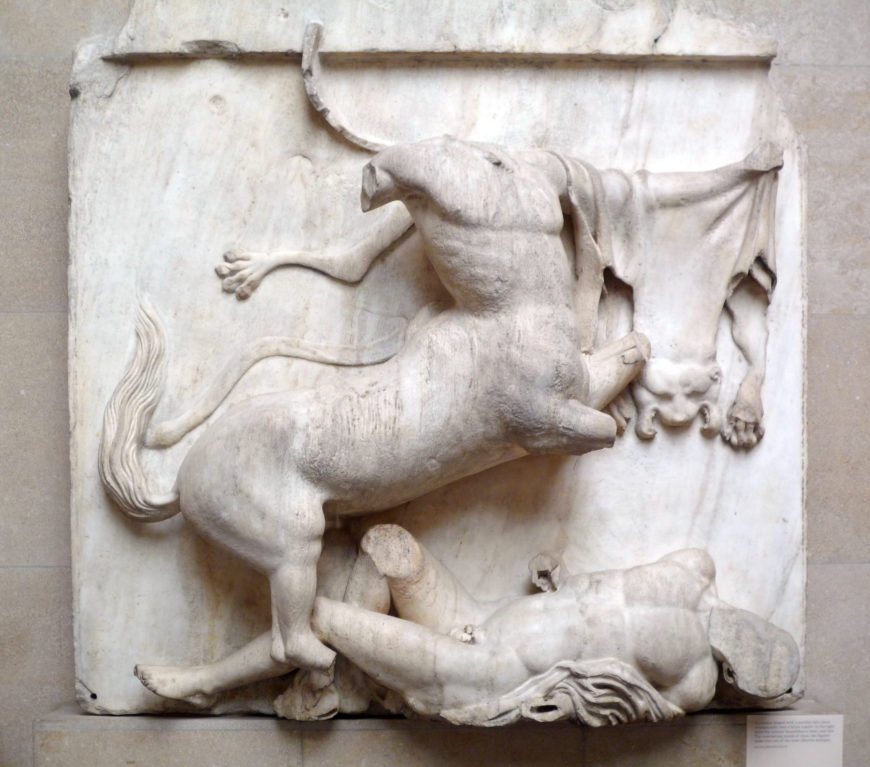
Battle of the Lapiths and Centaurs, Parthenon Metopes, south flank, marble, c. 440 B.C.E., Classical Period (British Museum, London; photo: Steven Zucker, CC BY-NC-SA 2.0)
While the architecture of the Parthenon referenced the past through re-use, the sculptures on the building did so more allusively, re-telling the history of the Persian Wars through myth. This re-telling is clearest on the metopes that decorated the exterior of the temple. These metopes had myths, for instance, the contest between men and centaurs, that recast the Persian Wars as a battle between good and evil, civilization and barbarism.
The metopes did not, however, depict this battle as one of effortless victory. Instead, they showed the forces of civilization challenged and sometimes overcome: men wounded, struggling, even crushed by the barbaric centaurs. In this way, the Parthenon sculptures allowed the Athenians to acknowledge both their initial defeat and their eventual victory in the Persian Wars, distancing and selectively transforming history through myth.
Thus even in what might commonly be understood as the moment of genesis for the Parthenon, we can see the beginning of its many lives, its shifting significance over time. Left in ruins from 480 to 447 B.C.E., it was a monument directly implicated in the devastating sack of the Acropolis at the onset of the Second Persian War. As the Parthenon was rebuilt over the course of the following fifteen years, it became one that celebrated the successful conclusion to that war, even while acknowledging its suffering. This transformation in meaning presaged others to come, more nuanced and then more radical.
Hellenistic and Roman Adaptations
By the Hellenistic era if not before, the Parthenon had taken on a canonical status, appearing as an authoritative monument in a manner familiar to us today. It was not, however, untouchable. Instead, precisely because of its authoritative status, it was adapted, particularly by those who sought to present themselves as the inheritors of Athens’ mantle.
The Parthenon was altered by a series of aspiring monarchs, both Hellenistic and Roman. Their goal was to pull the monument, anchored in the canonical past, toward the contemporary. They did so above all by equating later victories with Athens’ now-legendary struggles against the Persians.
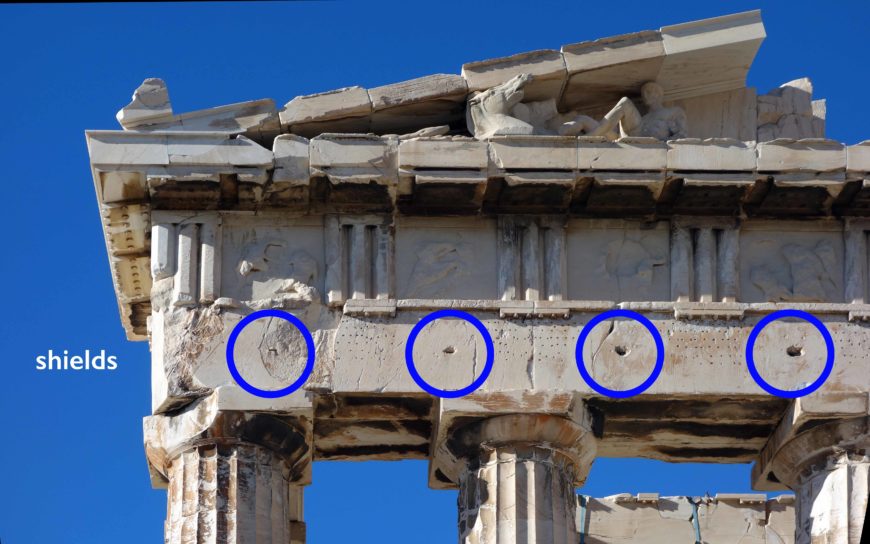
We can still see traces of the Persian shields from Alexander the Great that were at one point below the metopes. The blue circles indicate roughly were they would have been located (photo: Steven Zucker, CC BY-NC-SA 2.0)
The first of these aspiring monarchs was the Macedonian king Alexander the Great. As he sought to conquer the Achaemenid Empire—alleging, as one casus belli, the Persian destruction of Greek sanctuaries one hundred and fifty years earlier—Alexander made good propagandistic use of the Parthenon. After his first major victory over the Persians in 334 B.C.E., the Macedonian king sent to Athens three hundred suits of armor and weapons taken from his enemies. Likely with Alexander’s encouragement, the Athenians used them to adorn the Parthenon. There are still faint traces of the shields, once prominently placed just below the metopes on the temple’s exterior. Melted down long ago due to their valuable metal content, the shields must have been a highly visible memento of Alexander’s victory—and also of Athens’ subordination to his rule.
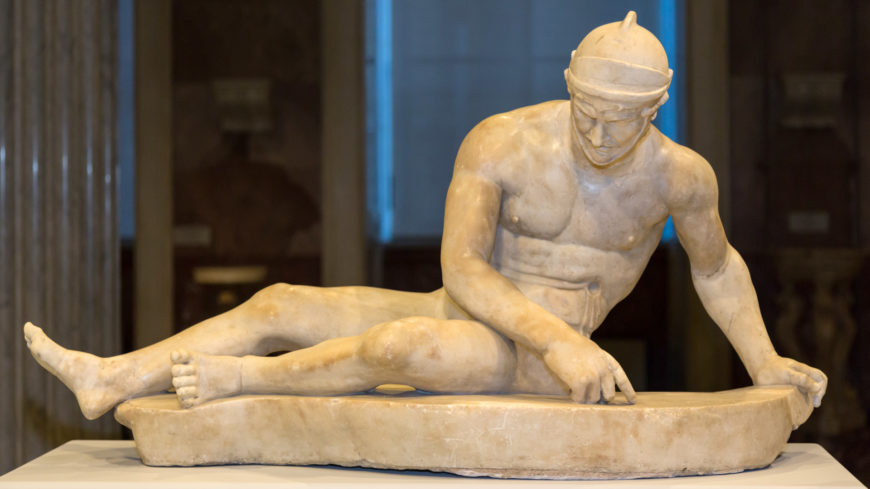
Wounded Gaul, from the Small Pergamene Votive Offering, Roman copy of the 2nd century C.E.. from a Greek original of the 2nd century B.C.E. (Museo Archeologico Nazionale, Naples)
Some two centuries later, another Hellenistic monarch set up a larger and more artistically ambitious dedication on the Acropolis. Erected just to the south of the Parthenon, the monument celebrated the Pergamene kings’ victory over the Gauls in 241 B.C.E. It also suggested that this recent success was equivalent to earlier mythological and historical victories, with monumental sculptures that juxtaposed Gallic battles with those of gods and giants, men and Amazons, and Greeks and Persians. Like the shield dedication of Alexander, the Pergamene monument made good use of its placement on the Acropolis. The dedication highlighted connections between the powerful new monarchs of the Hellenistic era and the revered city-state of Athens, paying homage to Athens’ history while appropriating it for new purposes.
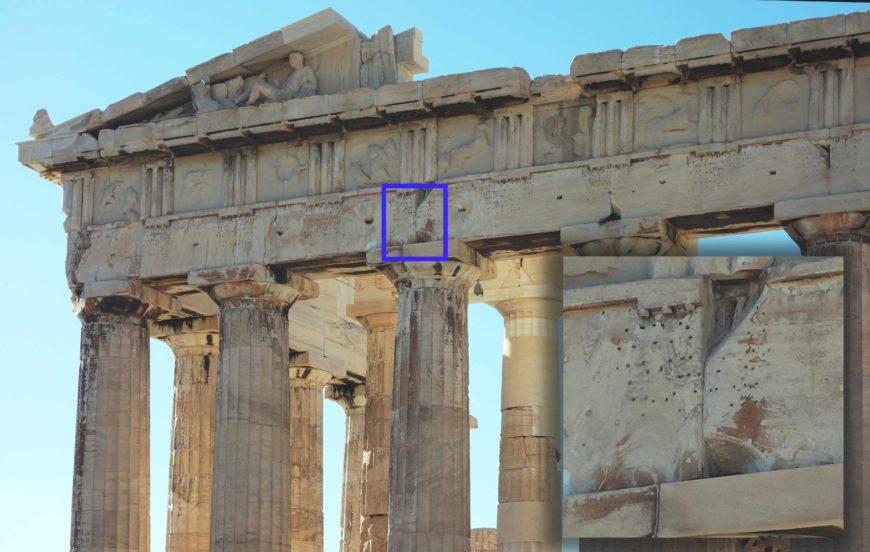
Holes for bronze letters of an inscription honoring the Roman emperor Nero on the east façade of the Parthenon, created and then removed in the 60s C.E. (photo: Steven Zucker, CC BY-NC-SA 2.0)
A final royal intervention to the Parthenon came in the time of the Roman emperor Nero. This was an inscription on the east facade of the Parthenon, created with large bronze letters in between Alexander’s previously dedicated shields. The inscription recorded Athen’s vote in honor of the Roman ruler, and was likely put up in the early 60s C.E.; it was subsequently taken down following Nero’s assassination in 68. The inscription honored Nero by connecting him to Athens and to Alexander the Great, a model for the young philhellenic emperor. Its removal offered a different message. It was a deliberate and very public erasure of the controversial ruler from the historical record. In this, Nero’s inscription (and its removal) was perhaps the most striking rewriting of the Parthenon’s history—at least until Christian times.
Reviewing the Hellenistic and Roman adaptations of the Parthenon, it is easy to see them purely as desecrations: appropriations of a religious monument for political and propagandistic purposes. And the speedy removal of Nero’s inscription does support this reading, at least for the visually aggressive strategies of the Roman emperor. At the same time, the changes of the Hellenistic and Roman eras are also testimony to the continued vitality of the sanctuary. Due to the prestige of the Parthenon, formidable monarchs sought to stake their visual claims to power on what was by now a very old monument, over four centuries old by the time of Nero. By altering the temple and updating its meanings, they kept it young.
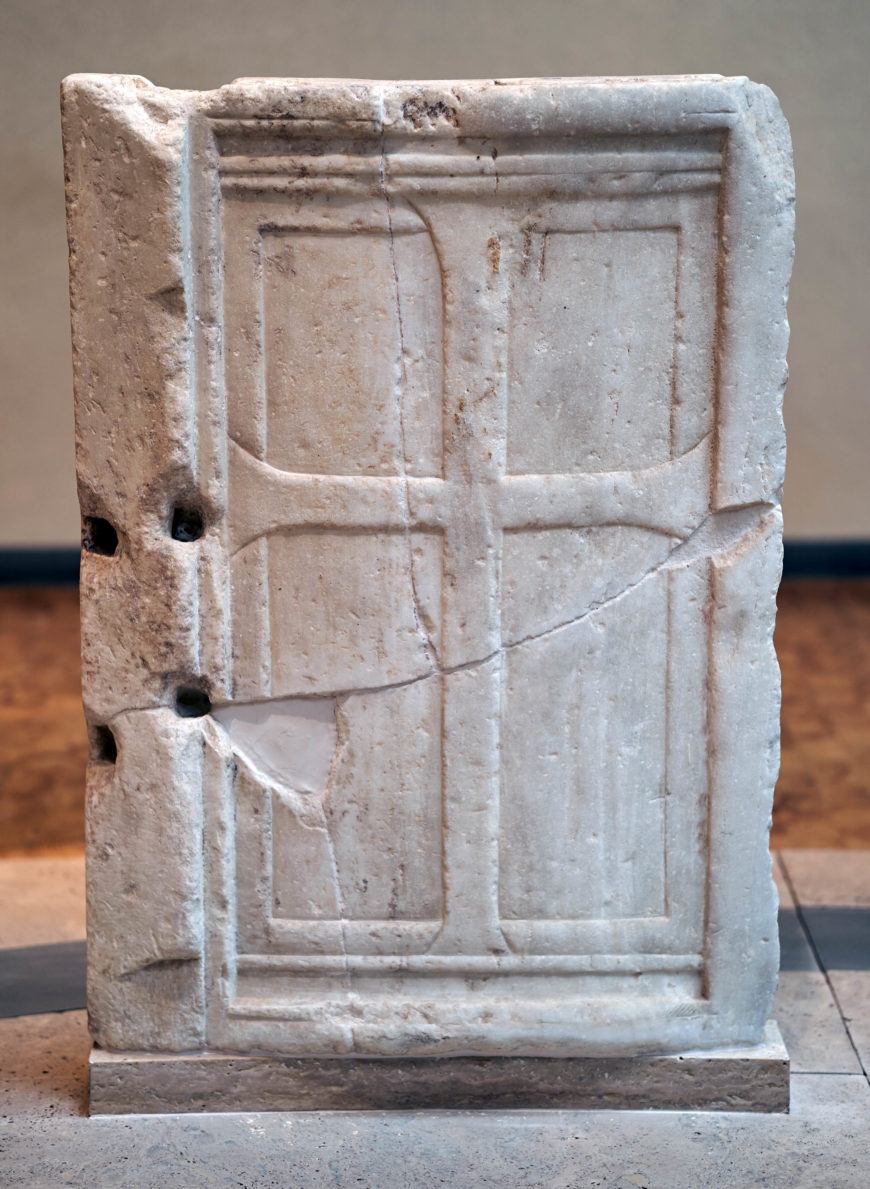
Marble closure slab with relief cross, from the pulpit of the Christian Parthenon, 5th–6th century (Byzantine and Christian Museum, Athens (photo: George E. Koronaios, CC BY-SA 4.0)
Early Christian Transformations
In ancient times, the most radical and absolute transformation of the Parthenon came as the Roman empire became Christian. At that point, the temple of Athena Parthenos was turned into an Early Christian church dedicated to the Theotokos (Mother of God). As with the rebuilding of the Parthenon in the mid-fifth century B.C.E., the decision to put a Christian church on the site of Athena’s temple was not just pragmatic but programmatic.
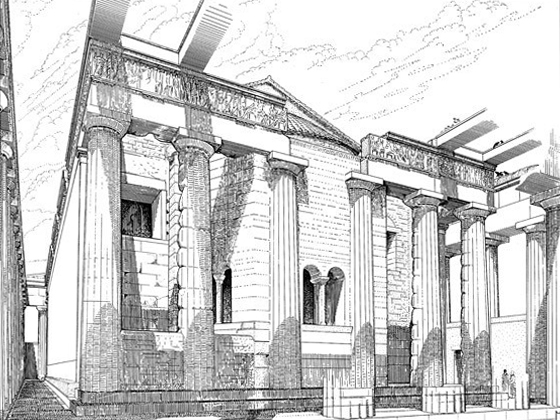
Reconstruction drawing of the church inside the Parthenon by M. Korres from Panayotis Tournikiotis, The Parthenon and Its Impact in Modern Times (New York, 1996)
By transforming the polytheist sanctuary into a space of Christian worship, it provided a clear example of the victory of Christianity over traditional religion. At the same time, it also effectively removed, through re-use, an important and long-enduring center of polytheist cult. This removal through re-use was a characteristic strategy used by the Christians throughout the Roman Empire, from Turkey to Egypt to the German frontier. In all these places, it formed part of the often violent, yet imperially sanctioned, transition from polytheism to Christianity.
The Christian transformation of the Parthenon involved considerable adaptation of its architecture. The Christians needed a large interior space for congregation, unlike the polytheists, whose most important ceremonies took place at a separate altar, outdoors. To repurpose the building, the Christians renovated the inner cella of the Parthenon. They detached it from its exterior colonnade, added an apse that broke through the columns at the east end, and removed from the interior the statue of Athena Parthenos that had been the raison d’étre of the polytheist temple.
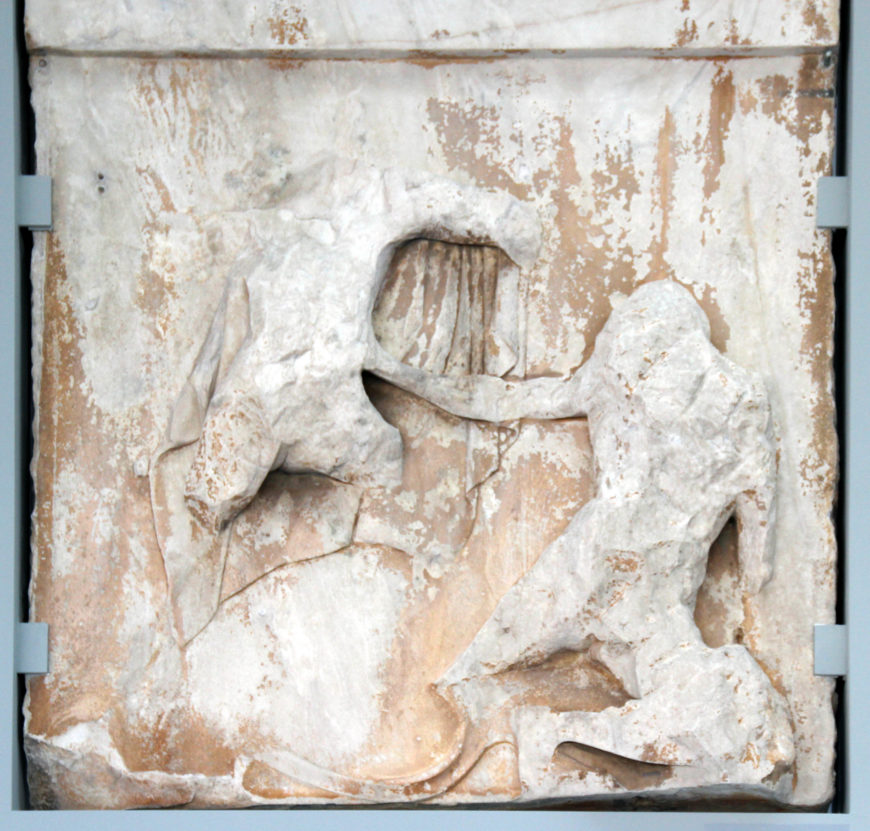
Metope from the east side of the Parthenon showing the battle of men and Amazons, heavily cut down by early Christians (photo: Gary Todd)
Other sculptures from the Parthenon suffered likewise from the Christians’ attentions. Most of the metopes—the lowest down and most visible of the Parthenon’s sculptures—were cut away, rendering them difficult to interpret or to use as a focus of polytheist cult. Only the south metopes with the centaurs were spared, perhaps because they overlooked the edge of the Acropolis and were thus hard to see. By contrast, the frieze (hidden between the exterior and interior colonnades) was left almost entirely intact, as were the high-up pediments. The differentiated treatment of the various sculptures on the Parthenon suggests negotiation between traditionalists and the more fervent of the contemporary Christians. Polytheists perhaps sacrificed the relatively small-scale and blatantly mythological metopes to keep the larger, better quality sculptures elsewhere on the monument. Examining the frieze, about one hundred sixty meters long and almost perfectly preserved, it seems like the polytheists got a good deal.
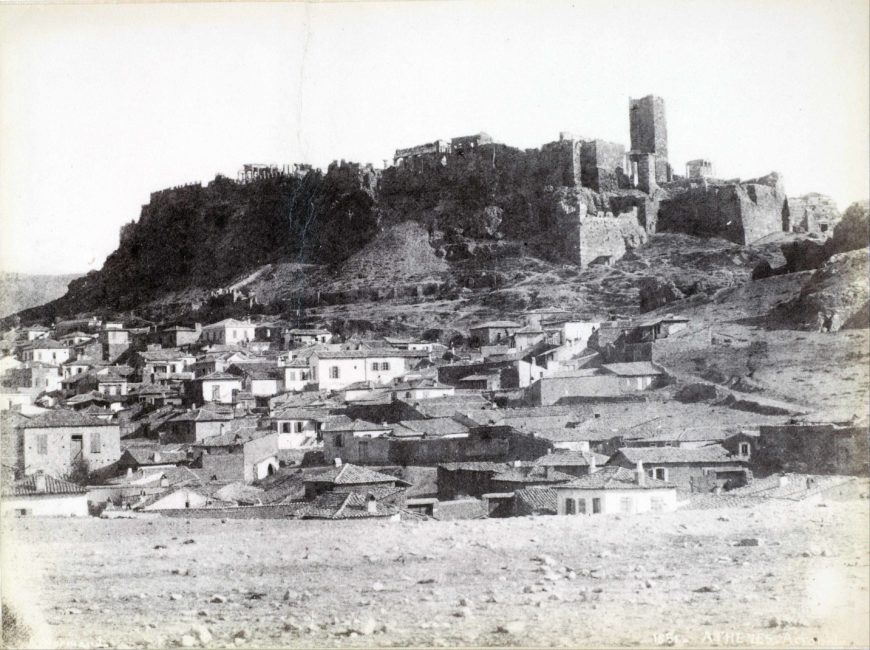
19th-century photographs show the Frankish tower and Ottoman dome (not visible here) that was once part of the Acropolis. Normand Alfred Nicolas, The northwest side of the Acropolis and the surrounding area, 1851, photograph (Benaki Museum, Athens)
Conclusions
Within and beyond the ancient world, the Parthenon had many lives. Rather than ignoring them, it is useful to acknowledge these lives as contributions to the building’s extraordinary continuing vitality. At the same time, one might note that the biography of the Parthenon (though accessible to specialists) has been decidedly effaced by the way it is presented now. When contrasting its present-day state with the first photographs taken in the mid-nineteenth century, we can see how much has been intentionally removed: a Frankish tower by the entrance to the Acropolis, an Ottoman dome, mundane habitations.

Iktinos and Kallikrates, Parthenon, Acropolis, Athens, 447—432 B.C.E. (photo: Steven Zucker, CC BY-NC-SA 2.0)
In its current iteration, the Acropolis has been returned to something resembling its pristine Classical condition, with no reconstructed monuments dating later than the end of the 5th century B.C.E. This feels like a loss: a retardataire effort to reinstate a selective, approved version of the past and to erase the traces of a more difficult and complex history. As such it stands as an example, and perhaps also a warning, for our current historical moment.
Additional resources
Jeffrey Hurwit, The Athenian Acropolis: History, mythology, and archaeology from the Neolithic era to the present (Cambridge: Cambridge University Press, 1999)
Rachel Kousser, “Destruction and memory on the Athenian Acropolis,” Art Bulletin 91, no. 3 (2009): pp. 263–82
R. R. Smith, “Defacing the gods at Aphrodisias.” In Historical and Religious Memory in the Ancient World, edited by R. R. R. Smith and B. Dignas (Oxford: Clarendon Press, 202), pp. 282–326

